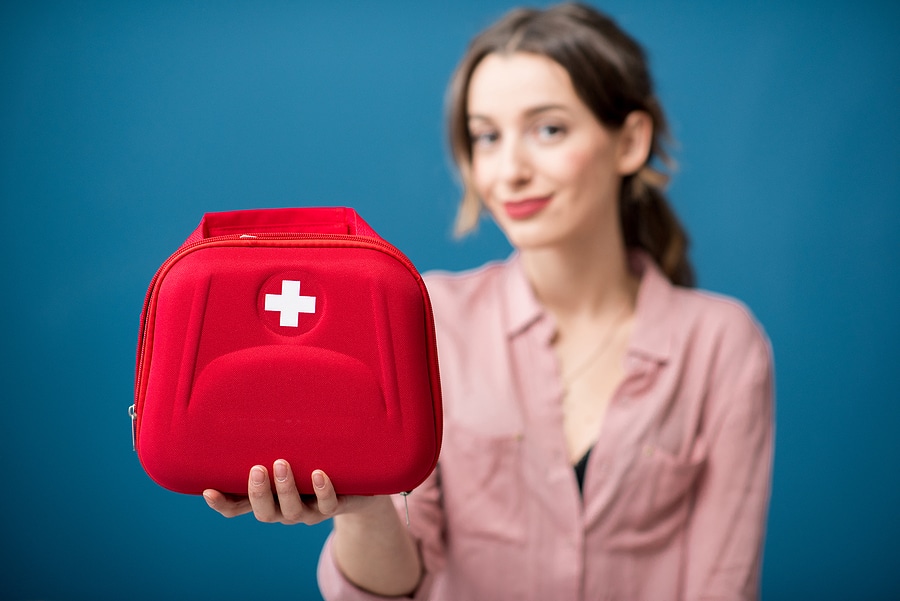People get hurt. And we’re not talking about breaking up or getting dumped. Accidents happen when you least expect them and it may be up to you to give first aid to the victim. You’ll do a better job if you have the first aid kit essentials you’ll need. Of course, you should also have basic first aid training, at least. In fact, this is a must for everyone. At least one person in a household should know how to administer first aid.
The goal of first aid is to administer immediate emergency care to someone who needs it. The injury may be as simple as a scratch or as bas as a gunshot wound. For the former, first aid is necessary to avoid infection. For the latter, first aid can spell the difference between life and death.
You can treat a gunshot wound with Band-Aids. Even if you think it’s unlikely for someone in your household to get shot, you still need to know how to treat the wound. You also need the right items to save the victim. Make sure you have everything you need to treat all kinds of injuries and illnesses. To give you a better idea, we listed down basic first aid kit items along. We also have the first aid kit essentials you will need to treat some specific emergencies.

Basic First Aid Kit Essentials
There are pre-packed first aid kits available in the market. You can opt for these if you prefer to have a good head start. Just purchase what is lacking so you’ll eventually have all first aid kit essentials at home.
Another option is to start your first aid kit from scratch. You can buy a wall-mounted first aid cabinet for your home. The good thing about this is that everyone knows where it is. As long as everyone puts the items back in the box then you shouldn’t have any problems finding what you need when you need it. The likelihood of misplacing your first aid kit should be null unless you take the whole thing off the wall and forget to put it back.
Of course, you can opt for a more portable first aid kit. In fact, you should have a portable first aid kit aside from the wall-mounted medical cabinet at home. You can take the whole thing with you if, for example, someone gets hurt outside.
Some of the basic items you’ll find in a first kit are the following:
- Band-Aids
- Sterile Gauze Rolls and Pads
- Compress Dressings
- Adhesive Bandages
- Triangular Bandage
- Bandage Strips
- Butterfly Bandages
- Eye Shield or Pad
- Aluminum Finger Splint
- Adhesive Cloth Tape
- Antiseptic Wipe Packets
- Hand Sanitizer
- Alcohol
- Cotton Balls
- Cotton Swabs
- Surgical Mask
- Examination Gloves
- Instant Cold Packs
- Thermometer
- Finger Splint
- Safety Pins
- Tweezers
- Scissors
- Over-the-Counter Medications
- Prescribed Medications
- Insect Repellent
- Multi-tool
- Flashlight
- Duct Tape
- Super Glue
- Sewing Kit
- Book on First Aid

First Aid Items for Specific Medical Issues
Burns
Antibiotic Ointment, Non-Adhesive Pads, and Pain Reliever
You can easily get burned while cooking or if you touch a hot surface like an iron. For minor burns, immerse the affected area in cool water for up to 15 minutes. Don’t use ice or cold water. Once the wound has cooled, cover the area with non-adhesive pads. Don’t use bandages that stick to your skin.
Apply antibiotic ointment to protect from infection. If the patient can’t handle the pain, give them over-the-counter pain relievers such as ibuprofen (Advil) or acetaminophen (Tylenol). Make sure they are not allergic to these medications.
Second- and third-degree burns will need immediate professional help. Call 911 while giving first aid to the victim. You may need to treat them for shock.
Fracture
Splint, Arm Sling, and Triangular Bandage
Fractures can happen at home. You can be up on the roof fixing something and accidentally slip and break a bone when you hit the ground. Or you could be pretending to be an MMA fighter and break your tibia and fibula while attempting a leg kick.
The point is you need to be prepared to treat broken bones. When someone suffers a fracture, you need to watch out for signs they need emergency help immediately. Such signs include a deformed limb or joint, bone protruding from the skin, heavy bleeding, broken neck or spine, or unresponsiveness. In such severe cases, avoid moving the victim unless really necessary.
Apply pressure on bleeding wounds using a sterile bandage or clean cloth. Ice packs can be used to relieve some of the pain but don’t place directly on the skin, especially on open wounds. Perform CPR if the victim is not breathing or has no heartbeat. Wait for emergency medical services.
To immobilize a fractured bone, you need an arm sling or a splint. If you don’t have a sling, you can use a triangular bandage.
Hypothermia
Thermal Blankets, Body Warmers, and Warm Compress
Frozen lakes are perfect for practicing your hockey and skating moves. They can also be dangerous. A study conducted by PLOS One said that 44% of winter drowning deaths were children under 9 years old. It also determined that people 15 to 39 years old were “vulnerable to drowning through ice as the youngest children,” as well.
Whether or not you live near a lake, you should have body warmers in your first aid kit and other emergency kits. When someone is exposed to extreme cold temperatures, one of the first things you should do is to warm the body. Remove wet clothes and cover the victim with layers of dry clothes, wool blankets, and thermal blankets. Use hand and body warmers to further keep them warm. A warm compress will also help. If possible, give the victim, something warm to drink. Don’t forget to call for medical emergency services.

Stab Wound
Tourniquet
Elliot Smith, Sharon Tate, and Nicole Brown Simpson are three of the high-profile stabbing deaths that rocked Hollywood. All crimes were committed while they were home. Not trying to scare you or something but you should definitely be wary of home intruders.
Administer first aid to a stab victim by stopping the bleeding. First, determine if the bleeding is external or internal. Wear gloves to be safe from blood contamination.
You need to stop the blood flow. Apply pressure directly on the wound then cover with a sterile non-adherent dressing. If the bleeding won’t stop, you can use a tourniquet, particularly if the stab wound is on the limbs. You need proper first aid training so you can use a tourniquet and treat profusely bleeding wounds correctly.
If the nearest medical facility is a day or more away, you may need to close the wound yourself. If things get really bad, your training on how to suture a wound will definitely come in handy. Keep suturing supplies in your first aid kit. You’ll need a sterilized needle and thread, needle driver, tissue forceps, and a pair of scissors.
Gunshot Wound
Chest Seal and Compression Bandage
Few things can be as horrifying as getting shot or seeing a loved one bleeding from a gunshot wound. It may seem like a scene from a movie but these things happen in real life. Even if you don’t have enemies who’d wish you dead, you should still know how to treat gunshot wounds.
When someone gets shot, you should first make sure the coast is clear. Call 911 once it’s safe. Provide first aid to the shooting victim by first locating the entry and exit wounds. Put pressure directly on the wounds. Use dressings and compression bandages to help the blood clot and seal the wound. For gunshot wounds to the limbs, use a tourniquet to stop the bleeding.
Chest wounds need to be sealed as soon as possible. Make sure you have chest seals in your first aid kit. These first aid kit essentials are specifically designed to treat a sucking chest wound. If left untreated, the wound will result in collapsed lungs.

When it comes to major medical emergencies, you only have a few minutes, seconds even, to help and hopefully save the victim. Aside from getting proper training, you should also have all the possible first-aid kit essentials within your grasp. This will increase your chances of helping the victim survive. Gentleman Pirate Club talks about different survival tips and skills that you may find helpful during medical emergencies.
Just a disclaimer – We have partnered with these companies because we use their products and/or proudly trust and endorse them – so we do receive a commission if you make a purchase or sign up for services. Often, we are able to negotiate special discounts and/or bonuses, which we will pass on to you via our links. We often get short notice on sale items available for 24-48 hours as we will pass these savings on to you.
























